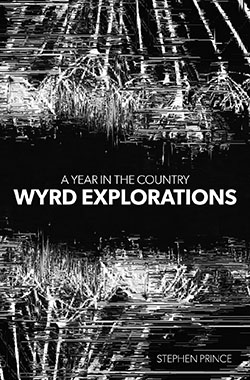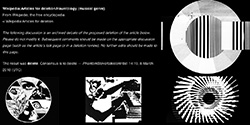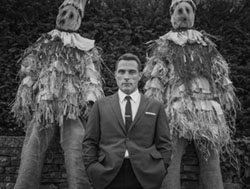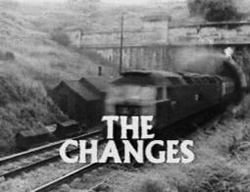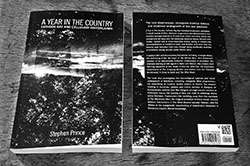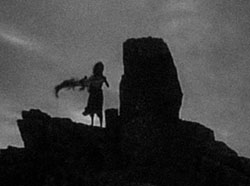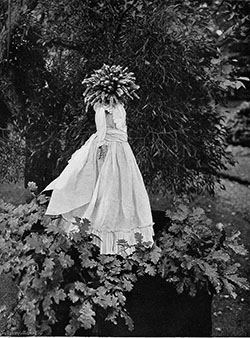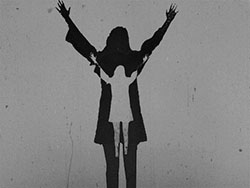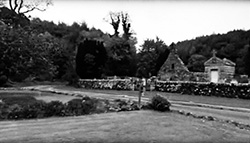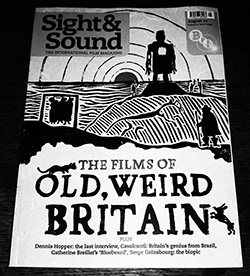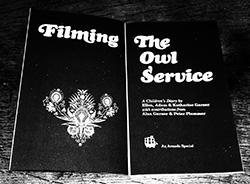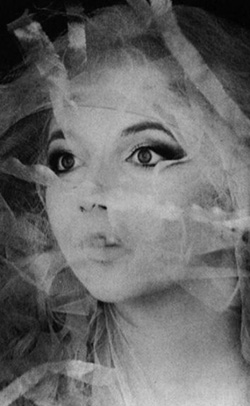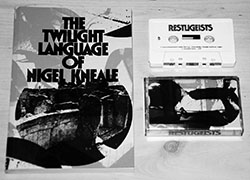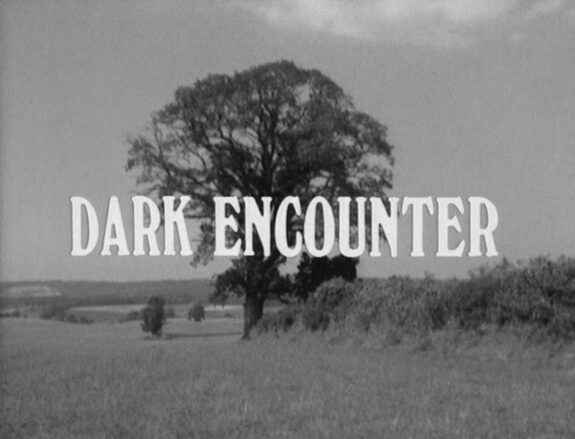
The “Dark Encounter” is an episode of the television series Shadows, which as I wrote in an earlier post:
“was a supernatural and fantasy young adult orientated British television anthology drama series that featured 20 approximately half-hour stand alone episodes, and was produced by the commercial broadcaster Thames Television and broadcast for three seasons between 1975 and 1978. It is part of the strand of late 1960s and 1970s British television that also included the likes of The Owl Service (1969-1970), The Changes (1975), Children of the Stones (1977) and Raven (1977), which often contained and explored surprisingly complex, challenging and at times dark themes and atmospheres, particularly considering its intended younger audience, and which in part due to these characteristics has become a reference point for hauntological related and/or otherly pastoral or wyrd culture.” (Quoted from the A Year In The Country post “Shadows Episode ‘The Inheritance’ and the Layering of Ancient Folklore and Myth”.)
Susan Cooper wrote “The Dark Encounter” episode and it was originally broadcast in 1976 as part of the series’ second season and it could be considered to be part of the folklore and myth infused strand of young adult literature in related earlier work by its writer Susan Cooper, and also other books published in the 1960s and 1970s, including Josephine Poole’s Billy Buck (1972), William Rayner’s Stag Boy (1971), Penelope Lively’s The Wild Hunt of Hagworthy (1971) and Alan Garner’s The Owl Service (1967).

I discuss those books in the above “Shadows Episode ‘The Inheritance’…” post and how what has been called at the whistleinthewind site as being the “invasion of ancient folklore and myth into the present” in fictional young adult orientated work was also something of a recurring feature of 1970s British television: examples of such work include the previously mentioned The Changes and also Raven (1977) and The Moon Stallion (1978) that draw from Arthurian legend; alongside “The Inheritance” episode of Shadows, which I also discuss in the above post; and some of the other episodes of Shadows including “Peronik”, which takes as its basis the ancient Celtic mythology Grail legend of the quest of Peronik.
Between 1965 and 1977, Susan Cooper published The Dark is Rising Sequence of five contemporary set young adult novels, which could also be considered to be interconnected with the above strands of fiction and television. They draw from Arthurian legends, English folklore and Celtic and Norse mythology and have been called “one of the [young adult fiction] cornerstones of Wyrd Britain” by Ian Holloway at his Wyrd Britain site, and
Although it does not make explicit reference to the book sequence, the “Dark Encounter” episode appears to be set in a similar story world as it, with both depicting a struggle between the forces of good and evil called the Light and Dark, and both also featuring a young boy who is destined to do battle on the side of the Light. Alongside which, as with “The Inheritance”, the episode veers towards the territory and tropes of folk horror.
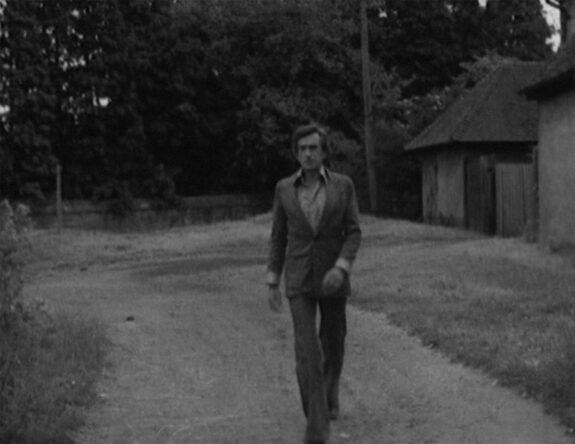
In a narratively and conceptually multi-layered story “Dark Encounter” tells of a 47 year old actor named Jonathan Brent who returns in contemporary times for a holiday in a rural area that he was evacuated to during the Second World War. He talks with the proprietor of the hotel where he is staying about how he cannot remember much about his time there as a child but that something in a field near to an old mill greatly scared him, and he has never felt easy with trees. She attempts to suggest and direct where he might go for a walk, and when he is pictured in the fields wearing a suit, the style of which would be more at home in an urban environment, he very much appears an alien outsider figure amongst the landscape, while at the same time there is a sense that something is drawing him back to the rural events and locations from his past.
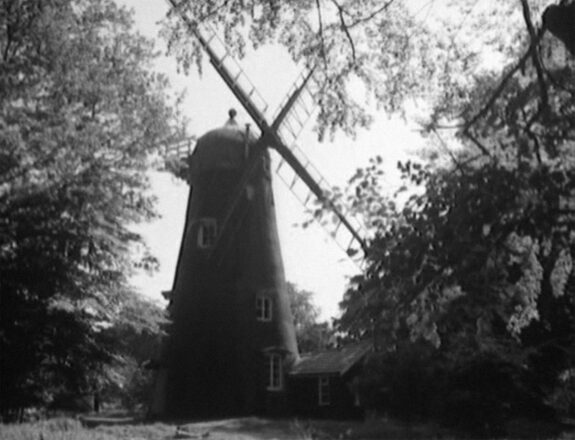
Brent comes across a young boy who has injured his ankle after falling from a large oak tree when he was attempting to rescue his kite. The actor gives him a piggyback to a nearby cottage which is next to a windmill, where the boy says he should be able to get help. When he enters the cottage Brent has unknowingly stepped over a threshold into some other form of reality where he is the “chosen one”, who three times in his life must do battle with the Dark, in order to stop it taking over the world.
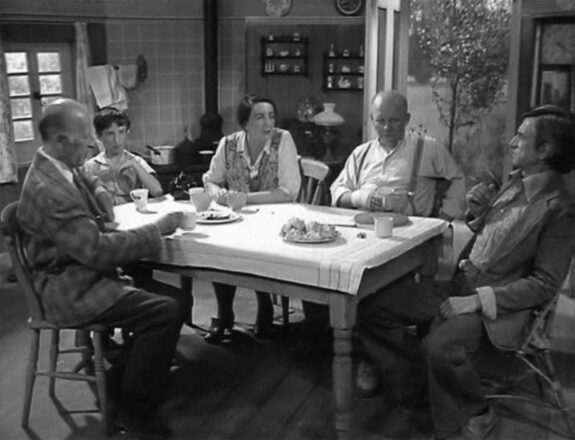
He does not immediately realise what is happening nor notice anomalies such as the date being 1941 on a wall calendar, that the windmill is in fact one which he was told at the hotel no longer exists or remember having fought this battle once before when he was young. Slowly his role is explained and revealed to him by the three adults in the cottage, who also tell of how they are in this place and continuum forever, and that they are a form of helpers in the battle against the Dark. His being uneasy with trees is shown to be a result of his previously doing battle with the Dark residing in them when he was young, and one of the helpers tells him:
“The Dark needs to rise in a living thing… and it did choose that oak tree in which to dwell… you know they used to say in these parts in the old days that just as time was divided by the day and the night, so the world itself was divided by two great forces, the Light and the Dark. Good and evil. And every so often on Midsummer’s Eve the Dark tries to take over control of the world for itself alone. And the Light chooses one man whose courage must keep the dark out.”
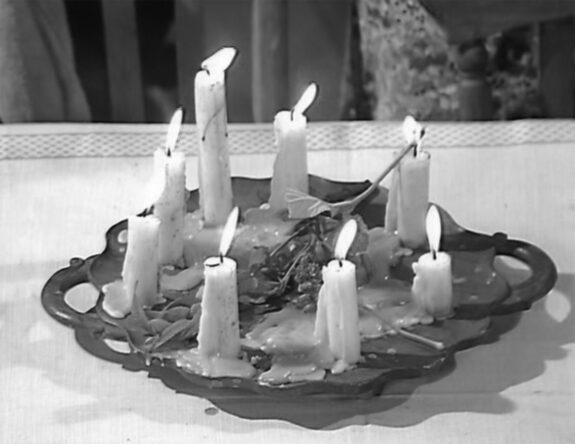
The “helpers” prepare for his second battle with the Dark by ritualistically placing a plate with lighted candles on a table in the middle of the house, and dropping various parts of plants on to it, such as witchwood (aka mountain ash), which has been used traditionally to ward off evil. After this Brent joins forces with the young boy he helped in order to fight the Dark through their mental courage. The boy is actually himself from an earlier time, and as they do battle together with the Dark their faces merge and fade into one another and a branch of the “Dark” infused oak tree smashes through a window. Other than this the depiction of the battle does not utilise extensive special effects but still manages to create an unsettling and chilling atmosphere.
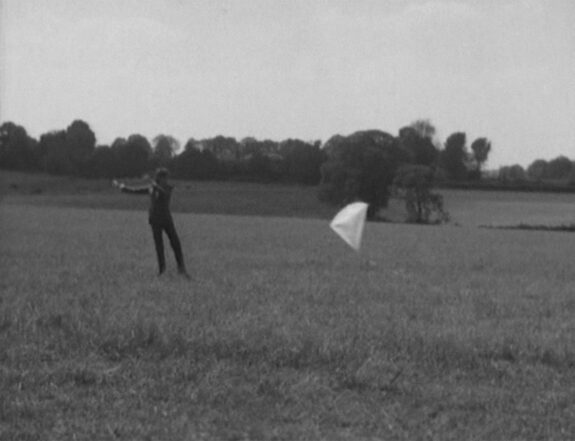
Once the battle is over the boy and Brent suddenly reappear in the fields in contemporary time, with neither of them seeming to remember their experiences, and as Brent attempts somewhat unsuccessfully to demonstrate his skill at kite flying the boy disappears, presumably returning to his own (and therefore Brent’s earlier) time. When Brent returns to his hotel the proprietor has a knowing air about her and she subtly implies that, as with the helpers in the cottage, she knows his role in fighting the Dark, and that she will also always be there to guide him and those who follow in his footsteps.
The episode inverts the way that trees are often associated with goodness and positive forces, and in this it is not dissimilar to the television drama “The Ash Tree”, which was an adaptation by David Rudkin of a story by M.R. James originally published in 1904, and that was broadcast around a similar time as “The Dark Encounter” in 1975. That also focuses around a cursed or evil infused tree and, as with Shadows, has come to be associated with the loose genre of folk horror and otherly pastoral or wyrd culture. In its depiction of possessed or evil trees, and the way the oak tree bursts through the window and attempts to attack the inhabitants, “Dark Encounter” is also somewhat reminiscent of the mainstream supernatural horror film Poltergeist (1982), in which a gnarled tree in a family’s garden supernaturally comes alive and grabs one of the family members through a window.

“Dark Encounter” also shares some similarities with the television drama “Robin Redbreast”, that was broadcast in 1970 as part of the BBC’s Play for Today strand and which has also come to be associated with folk horror. “Robin Redbreast” features an urban outsider who, as with Brent in “Dark Encounter”, is also involved in the entertainment industry, and as with Brent is shown as an outsider away from her normal urban home when she moves to the countryside. “Robin Redbreast” also involves a “chosen one” who, in this instance, is a special totem of the local pagan religion, although it is an adult orientated drama and somewhat darker in its themes than “Dark Encounter” as its plot revolves around the script editor becoming caught up in a folk ritual based conspiracy to sacrifice this human form of totem.
The sense of time slip and the “helpers” being in one place and instance of time forever in “Dark Encounter” also has similarities with the British television preternatural fantasy drama series Sapphire & Steel (1979-1982), which as with Shadows and some of the other 1970s young adult orientated British television drama series discussed at the start of this post, has become a reference point for hauntological culture.
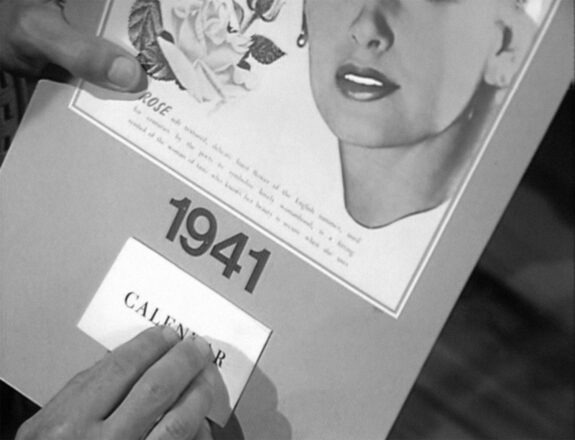
As with a number of the episodes of Shadows, including the time portal lens themed episode “The Other Window”, Sapphire & Steel deals with the porous nature of time, and it focuses on the activities of the titular interdimensional operatives who attempt to guard the correct flow of time, and who have to battle and correct elements which threaten this by crossing over from one time to another. Alongside their similarities in containing porosity of time based themes, the way in which the “helpers” in “Dark Encounter” remain forever in one time and place outside the bounds of reality seems to forebear the final desolate episode of Sapphire & Steel; as this ends the operatives are shown as being trapped, quite possibly for all time, in the location of a roadside cafe that is floating lost amongst the cosmos, and one of their betrayers satisfiedly and almost nonchalantly callously tells them “This place is nowhere. And it’s forever.”
As with Sapphire & Steel, “Dark Encounter” ends on an ambiguous note, which leaves the viewer’s imagination space to wonder (and wander); unlike Sapphire and Steel, Brent is left to roam free, but he has only so far carried out and won two of his lifetime’s three battles against the Dark, and whether he will be successful for a third time is left unclear.
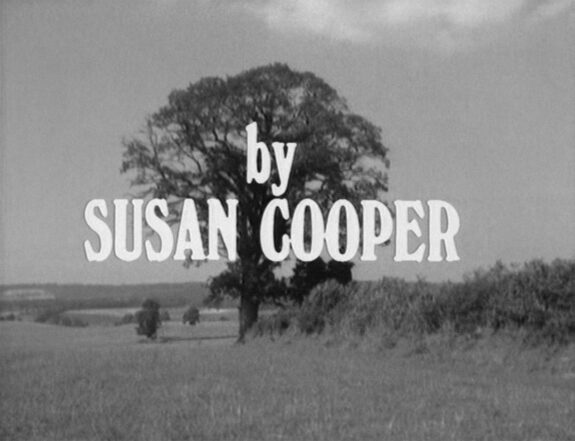
Elsewhere:
- The Shadows DVD released by Network (but £9 at the time of writing for the complete boxset, something of a bargain)
- Shadows’ premiere at the Talking Pictures TV archival television station
- The Wyrd Britain website
- The Robin Redbreast DVD at the BFI’s site
- The Changes DVD at the BFI’s site
- An exploration of the “invasion of ancient folklore and myth into the present” at the whistlesinthewind website
Elsewhere at A Year In The Country:
- Shadows Episode “The Inheritance” and the Layering of Ancient Folklore and Myth
- Russel Hoban’s “Come and Find Me” Episode of Leap in the Dark, Stone Tape Theory and the Porosity of Time
- Shadows and Otherly Introductions
- Raven – Unearthing Hidden Buried Power and Battles to Safeguard the Future
- She Wants to be Flowers – Filming The Owl Service
- The Owl Service, The Changes, Robin Redbreast, The Ash Tree, Sky, Penda’s Fen and Red Shift – Wanderings Through Spectral Television Landscapes
- The Intro to The Owl Service
- The Owl Service: fashion plates and (another) peek behind the curtain
- Filming The Owl Service; Tomato Soap and Lonely Stones
- The Ash Tree; Sacred Disobedience, an unorthodox guidance and further fields In England
- Robin Redbreast, The Ash Tree, Sky, The Changes, Penda’s Fen, Red Shift and The Owl Service – Wanderings Through Spectral Television Landscapes
- Sapphire and Steel; a haunting by the haunting and a denial of tales of stopping the waves of history…
- Sapphire & Steel, various ghosts in the machine and a revisiting of broken circuits…
- Sapphire & Steel and Ghosts in the Machine – Nowhere, Forever and Lost Spaces within Cultural Circuitry
- The Changes / The Disruption – Notes on a Flipside of the Pastoral Conversation
- The Changes, Threads the bad wires and the ghosts of transmissions
- Children Of The Stones intro


